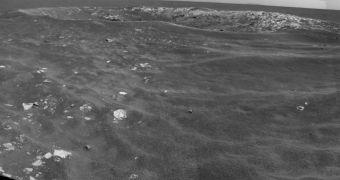Officials at the NASA Jet Propulsion Laboratory (JPL) announce that they have given a crater on the surface of Mars the informal name Freedom 7, after the spacecraft that astronaut Alan Shepard piloted during the United States' first spaceflight ever.
The event took place on May 5, 1961, and so the JPL team is releasing the news as part of the anniversary for this momentous occasion. It was Shepard that christened his space capsule Freedom 7, and so the science team in Pasadena decided to honor this.
The researchers are operating the Mars Exploration Rover (MER) Opportunity on the surface of the Red Planet, and the robotic explorer is currently located amidst a portion of land that is riddled with small craters of a relatively young age.
Of this cluster, the largest crater is now informally called Freedom 7. The landscape feature is about 82 feet (25 meters) in diameter, which is the height of the Redstone rocket on which the first American manned spacecraft took off decades ago.
“This cluster has about eight craters, and they're all the same age. They're from an impactor that broke up in the atmosphere, which is quite common,” explains JPL scientist Matt Golombek.
It is common for landscape features on Mars to be named after astronauts or famous missions. A hill complex near the site where the MER Spirit landed was dubbed Columbia Hills, in honor of the shuttle that was lost in 2003.
The seven peaks in the Hills are each named after the seven crew members that lost their lives upon atmospheric reentry. The shuttle was lost due to damage that came to its heat shield during launch.
“Many of the people currently involved with the robotic investigations of Mars were first inspired by the astronauts of the Mercury Project who paved the way for the exploration of our solar system,” explains researcher Scott McLennan.
The expert, who is based at the State University of New York at Stony Brook, is this week's long-term planning leader for the rover science team. Opportunity has been surveying the surface of Mars for more than seven years, and is now officially the longest-lived mission on the Red Planet.
“The first 50 years of American manned spaceflight have been built upon immeasurable courage, dedication, sacrifice, vision, patriotism, teamwork and good old-fashioned hard work, all terms that embody and define the United States and her people,” says James Rice.
“Alan Shepard's brave and historic 15-minute flight in Freedom 7 put America in space, and then a scant eight years later, Americans were standing upon the surface of the Moon,” he adds.
Rice, who is a member of the MER team, is based at the NASA Goddard Space Flight Center (GSFC), in Greenbelt, Maryland. After the Freedom 7 mission, Shepard went on to visit the Moon in 1971. He died on July 21, 1998, at the age of 74.

 14 DAY TRIAL //
14 DAY TRIAL //